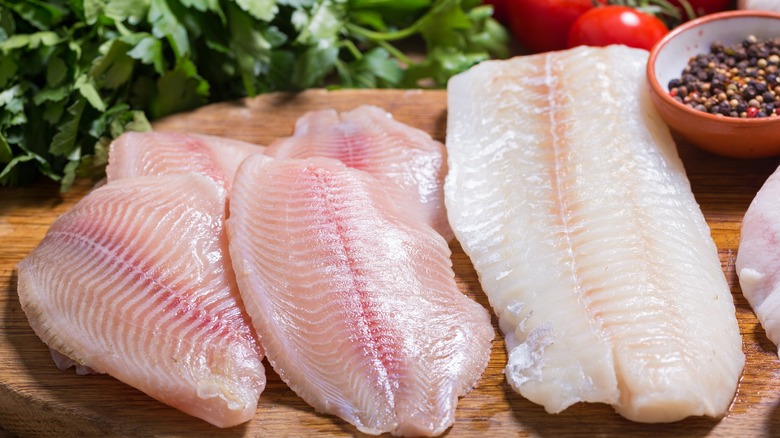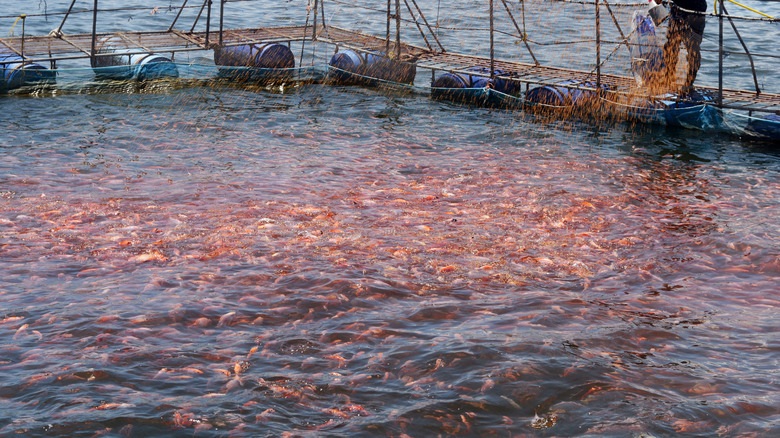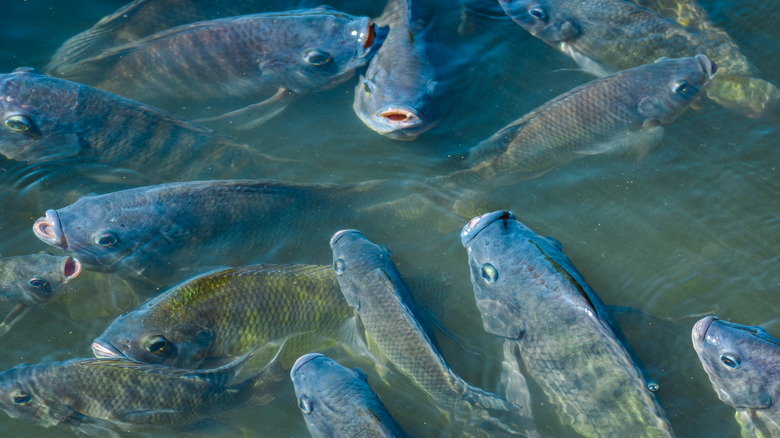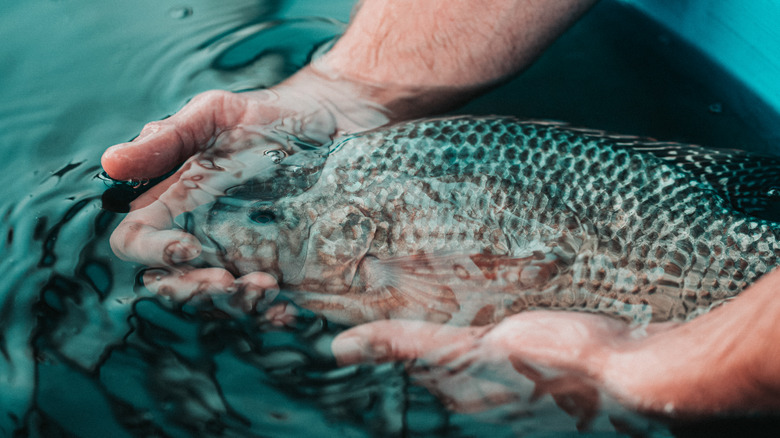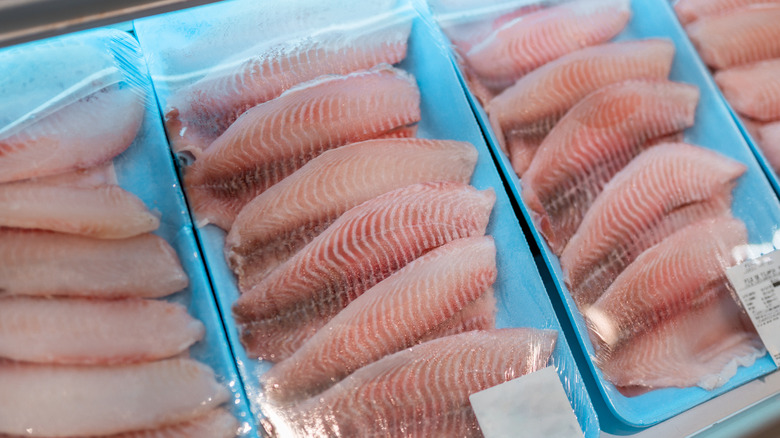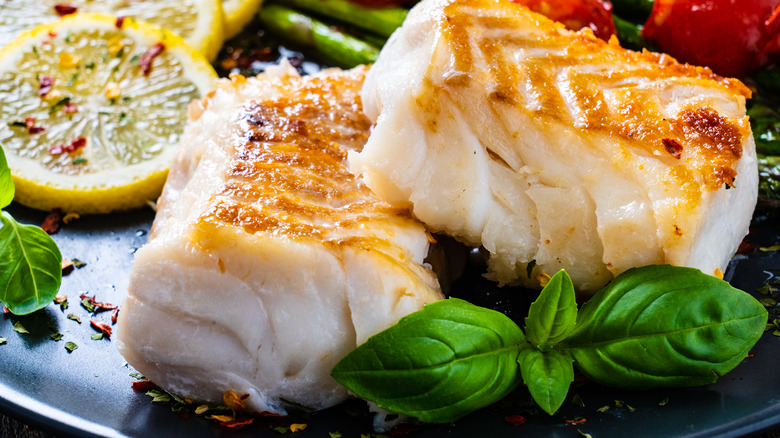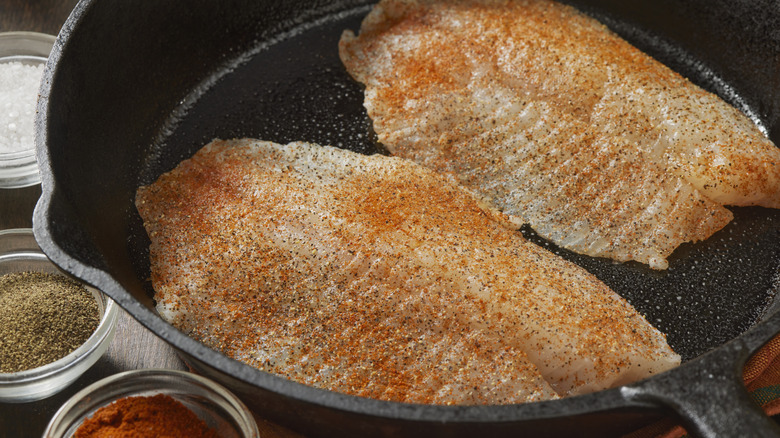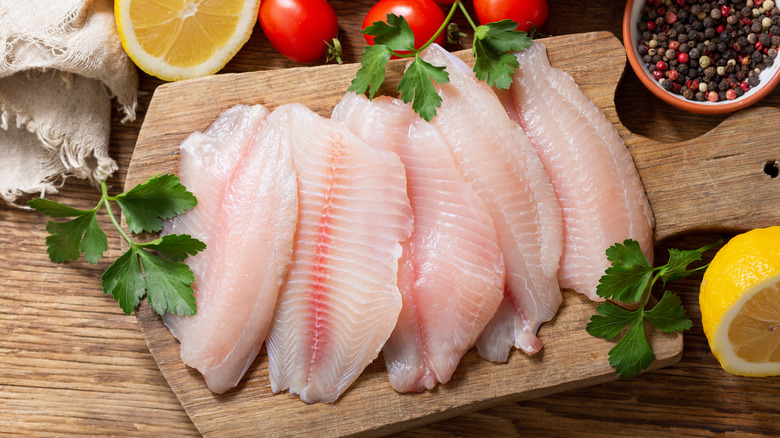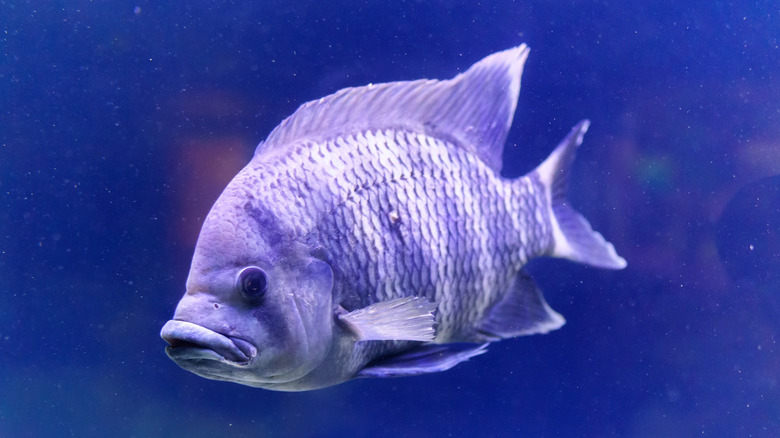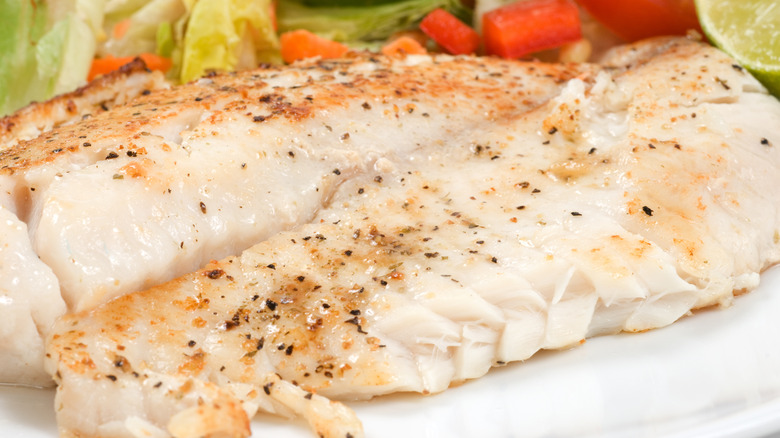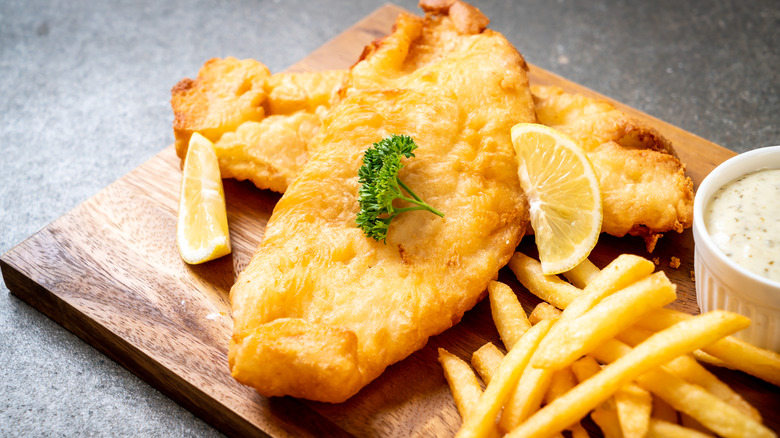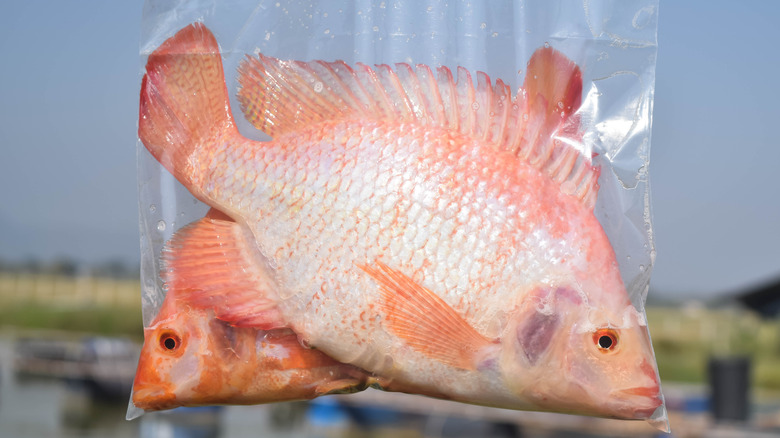Tilapia Vs Cod: Everything You Need To Know
Modern nutritional wisdom dictates that we should all be eating more fish. As for how much, the British National Health Service provides a good baseline, recommending at least two portions of fish a week, citing fish's richness in vitamins and minerals as a good reason to cook some up. Low in fat and high in protein, fish is a great option for those looking to cut down on their red meat consumption in favor of something more healthful, less inflammatory, and more sustainable.
But fish can be somewhat of an acquired taste, especially some of the oilier ones like sardines, anchovies, or salmon. Flaky white fish like cod and tilapia are far more approachable (and less overtly fishy), making them ideal ways to dip your toe in the water. At the outset, it may seem as though cod and tilapia are fairly similar to one another, but in reality, these two flaky white fishes boast a host of differences. To add some clarity to the murky waters surrounding these fish, we're diving deep into some of the major differences between tilapia and cod.
Tilapia is typically farmed, while cod is wild-caught
Tilapia's reputation as a "frankenfish" is a gross misunderstanding of the reality of this farm-raised fish. A member of the Cichlidae family of freshwater fish hailing from Africa, and indeed has been raised by humans since ancient Egypt. If tilapia has so long been popular to farm, it's because of its innate hardiness. Tilapia is particularly well-suited to intensive farming conditions and is easy to breed, while also known for its strength and quick growth. Seeing as tilapia is often bred in favor of these characteristics, the mass media occasionally reports that the fish is somehow not "real" or genetically modified. (Genetically modified tilapia does exist, but it's not available for sale in the U.S.)
Tilapia farms have gotten some flack in the past for unsustainable methods: overcrowding, overuse of antibiotics, and feed laced with everything from fish meal to agricultural byproducts to manure have left some sticking their noses up at tilapia. But these days, most farmed tilapia are fed a vegetarian, algae-based feed.
Cod, on the contrary, is normally wild-caught in either the Atlantic or the Pacific, though given the overfishing of many cod stocks, specifically in the Atlantic, some countries, including Norway, have begun farming the fish. Cod farming is still a relatively modest industry, with about 20,000 tons of farmed cod produced annually as of 2009, as compared to the approximately 1.3 million tons of Atlantic cod, and 165,200 tons of Pacific cod that are wild-caught each year.
Tilapia is a freshwater fish and cod comes from the sea
Tilapia — like all members of the Cichlidae family of fish — is a freshwater fish, thriving in warm environments, as it makes sense given its African heritage. Cod, meanwhile, is a saltwater fish native to both the Atlantic and the Pacific, a bounty that has long been wild-caught everywhere from Japan to New England. (Where did you think Cape Cod got its name from?)
Within the greater cod family, Atlantic cod tends to be a bit sweeter in flavor and boast a firmer texture due to its lower moisture content, as compared to Pacific cod, which tends to be smaller and not quite as rich in vitamins and minerals as its Atlantic cousin. Either way, as compared to freshwater tilapia, saltwater fish like cod typically have a fuller flavor and a saltier, brinier taste. But while most freshwater fish have a "fishier" flavor than their saltwater-raised counterparts, tilapia proves quite mild for the category.
Cod is slightly healthier than tilapia
Both cod and tilapia are lean protein sources that are low in calories, and boast some vitamins and minerals, albeit fewer than their oilier cousins. But there are a few nutritional differences between them, with cod just barely eking out first place in terms of its nutritional profile. A 3-ounce serving of cooked Atlantic cod boasts 90 calories and just 1 gram of fat for 19 grams of protein. Tilapia is slightly higher in calories, with 108 per 3-ounce cooked portion, and it's also slightly higher in fat, with 2¼ grams of fat. It has a bit more protein, too, at 22 ½ grams per portion.
When it comes to vitamins and minerals, cod comes out on top, boasting slightly more B6, thiamin, potassium, magnesium, phosphorus, calcium, and zinc than tilapia. Tilapia, however, does have a few tricks up its sleeve, with more vitamin B12, B15, iron, and selenium. At the end of the day, it comes down to the omega-3 fatty acids fish are known for. As compared to cod, tilapia has an unfortunately high ratio of omega-6 fatty acids as compared to those heart-healthy omega-3s, which research has shown can lead to general inflammation (via Healthline).
Tilapia is more likely to be contaminated
One of the major downsides of farmed fish like tilapia is the increased risk of contamination. While great strides have been made in improving the state of fish farms of late, specifically with regard to aquaculture industries that were once rife with issues like salmon and tilapia, the reality is that we still have work to do. Farmed tilapia has been shown to be contaminated with everything from Salmonella due to feed laced with livestock feces (via Systemic Reviews in Pharmacy) to drug residues due to the overuse of antibiotics in an effort to reduce illness in overcrowded populations (via ScienceDirect).
These days, due to advances in the industry in most places around the world, the fish most likely to be contaminated hail from China. Monterey Bay Aquarium's Seafood Watch even cites the presence of several long-banned toxic chemicals in Chinese-farmed tilapia. Choosing tilapia from the U.S., Canada, the Netherlands, Ecuador, or Peru will reduce the risk that the tilapia you source has been contaminated. Of course, cod isn't completely in the clear. Mercury contamination is a risk when consuming cod, particularly Atlantic cod. Pacific cod is likely to be a safer choice.
Tilapia is cheaper than cod
One of the major selling points for tilapia is its low price. While the price of tilapia can certainly vary depending on the season and where you are purchasing it, on average, whole fresh tilapia costs between $3 and $8 a pound in the U.S., with American tilapia being slightly more expensive at up to $10 a pound. Frozen tilapia is slightly cheaper than fresh, costing anywhere from $2 to $4 a pound, and tilapia filets are slightly more, between $10 and $15 a pound.
Cod, meanwhile, fetches a slightly higher price, somewhere between $3.63 and $5.90 per pound, with filets priced at around $14.99 per pound. As a general guideline, frozen fish will usually be cheaper, and you'll pay more for quality. Choosing sustainably sourced or organically farmed fish may cost a bit more, but it's worth it in the long run to reduce the risk of contamination.
Cod is meatier in texture than tilapia
While both cod and tilapia fall into the same category of flaky white fish, they don't have exactly the same texture. Cod is known for having a tender-firm texture, with Pacific cod being even thicker than Atlantic cod. The higher moisture content of Pacific cod means that it's not quite as firm as its Atlantic cousin, the latter of which may stand up better to certain cooking methods like frying. Atlantic cod is quite firm and meaty when cooked, with some even comparing it to chicken. While we wouldn't necessarily go that far, it does have a pleasant heft and chew to it.
Tilapia, meanwhile, has a lean, flaky texture that's nevertheless slightly denser than that of cod. When perfectly cooked, tilapia is fork-tender and easy to enjoy. It doesn't have quite the same heft as cod, but it's nevertheless less delicate than a thinner fish-like sole.
Tilapia has a sweeter flavor than cod
While both tilapia and cod are mild white fish, they do have some slight differences in terms of flavor. Cod is quite lean and boasts a very slight sweetness, especially the Atlantic variety. Like other saltwater fish, cod also has a bit of a briny quality to it that's quite welcome. Cod is frequently paired with miso in Japanese cooking, and the rich umami flavor and mild sweetness of the fermented soybean paste highlight these undertones in the fish itself.
Tilapia, meanwhile, while also mild, has a bit more of a pronounced sweetness to it, and its mild flavor quickly gets lost if the fish is cooked with a sauce or spice rub. (Not that it's necessarily a bad thing, especially if you're trying to convert a former fish-phobe!) At the end of the day, however, neither cod nor tilapia is particularly fishy, making either one a great choice for those who aren't sure they like fish.
Tilapia is more popular than cod in the U.S.
Both cod and tilapia are fairly popular choices among American consumers, but tilapia outranks cod slightly when it comes to U.S. sales. Data from 2018 shows that Americans consumed an average of 1.11 pounds of tilapia per person, as compared to just .62 pounds of cod (via Intrafish). And what's more, consumption of tilapia has long been on the rise, with sales quadrupling from 2003 to 2007, and a 2.8% growth rate in 2018. Cod, meanwhile, was on the decline, with -6.1% progression year-on-year.
This corresponds with a slight year-on-year increase in seafood consumption overall in the U.S., with a general rise in consumption from a recent low of 14.2 pounds per person per year in 2011 to 16.1 pounds per person in 2018. (Pre-2012, seafood consumption was hovering somewhere between 15.6 and 16.5 pounds per person.) By 2021, Americans had consumed a record 20.5 pounds of seafood per person, which represented a 1.5-pound increase over 2020 (via National Fisheries Institute). That's far less than elsewhere around the world: Europeans and Japanese eat an average of about 50 pounds of fish and seafood per person.
Tilapia is more sustainable than cod
Tilapia's ever-growing popularity among Americans is likely linked to a recent marketing push: after all, especially given rampant overfishing and depleted wild stocks, farmed tilapia is emerging as one of the more sustainable fish out there. While environmentally sustainable tilapia certainly does not make up the entirety of tilapia production, farmed tilapia from Ecuador and Peru earns Seafood Watch's Best Choice rating — especially when it's been certified by the Aquaculture Stewardship Council, BAP Certified, or Naturland.
Cod, on the other hand, has been overfished for decades, contributing to the near collapse of the Atlantic fishery in the early '90s. These days, Seafood Watch recommends seeking out Pacific cod caught in Alaska, California, Oregon, Washington, or British Columbia and avoiding Atlantic cod unless you can confirm it was caught with pole-and-lines in the U.S. Georges Bank or U.S. Gulf of Maine. Other Atlantic cod populations are depleted and rife with issues linked to bycatch. The same holds for Pacific cod caught in Japan and Russia; in Japan specifically, bycatch and overfishing are serious concerns.
Tilapia is more forgiving to cook than cod
When choosing between tilapia and cod, inexperienced cooks would do well to opt for the former: Given its leanness, cod is particularly easy to overcook — and once it's overcooked, there's no turning back. Just a few seconds too long in the pan or under the broiler will result in cod that's tough and dry, with a rubbery, chewy texture that's far from appetizing.
While it's a myth that tilapia is impossible to overcook, it is indeed quite a bit more forgiving of slight overcooking than cod, given its slightly higher fat content. And that's not all. Thanks to its mild flavor, tilapia is particularly well-suited to marinades, which can make it even more forgiving, given the added moisture and fat certain marinades impart. When in doubt, adding a bit of butter goes a long way in giving you a tilapia dish that's flavorful and moist.
Cod is better for fish and chips than tilapia
Certain recipes demand certain specific fish, and British stalwart fish and chips is one of them. While there are a number of different fish that could work in fish and chips, including pollock and hake, which are both pretty traditional choices, tilapia does not make the best fish and chips out there.
Despite pressure from experts who cite the sustainability of tilapia as a good motivation to choose this fish over cod, the flakiness of tilapia tends to make it fall apart in recipes like fish and chips, especially if you're going the slightly healthier route and baking rather than frying your fish.
Cod, meanwhile, is a no-brainer for fish and chips, with its thick, meaty filets and mild flavor. It's no wonder it's the most popular fish sold at British chippies, making up more than 60% of the offer, especially in the south of England. If you have a choice, Pacific cod is even better than Atlantic, thanks to its moist texture and mild flavor.
Tilapia is generally more humanely killed than cod
It's never fun to think about it, but whenever we consume animals, we have to consider the way in which they are slaughtered — and when it comes to the tilapia vs. cod debate, the former is generally processed in a far more humane way. Tilapia farms can, of course, be overcrowded and inhumane, but great strides have been taken of late to ensure this is no longer the case, something that holds twofold when it comes to methods of slaughter.
As opposed to traditional fishing, where fish are frequently left to asphyxiate in the air, fish farms, including tilapia farms, have begun relying chiefly on humane stunning methods for slaughter. This technique kills the fish instantly, reducing stress. This method isn't just more humane for the fish itself — it also contributes to a far better product, given the reduction in the production of stress hormones. This process is slowly being adopted by some humane-minded wild fisheries as well, including some who are experimenting with electrical stunning to slaughter wild-caught cod.
